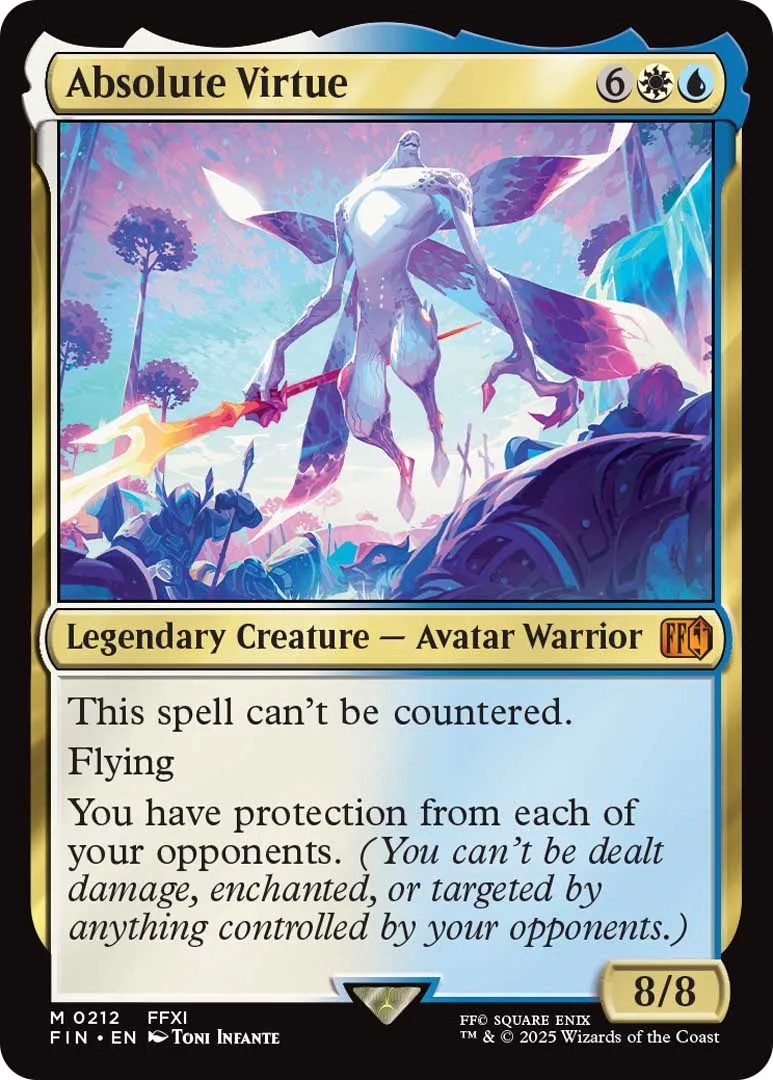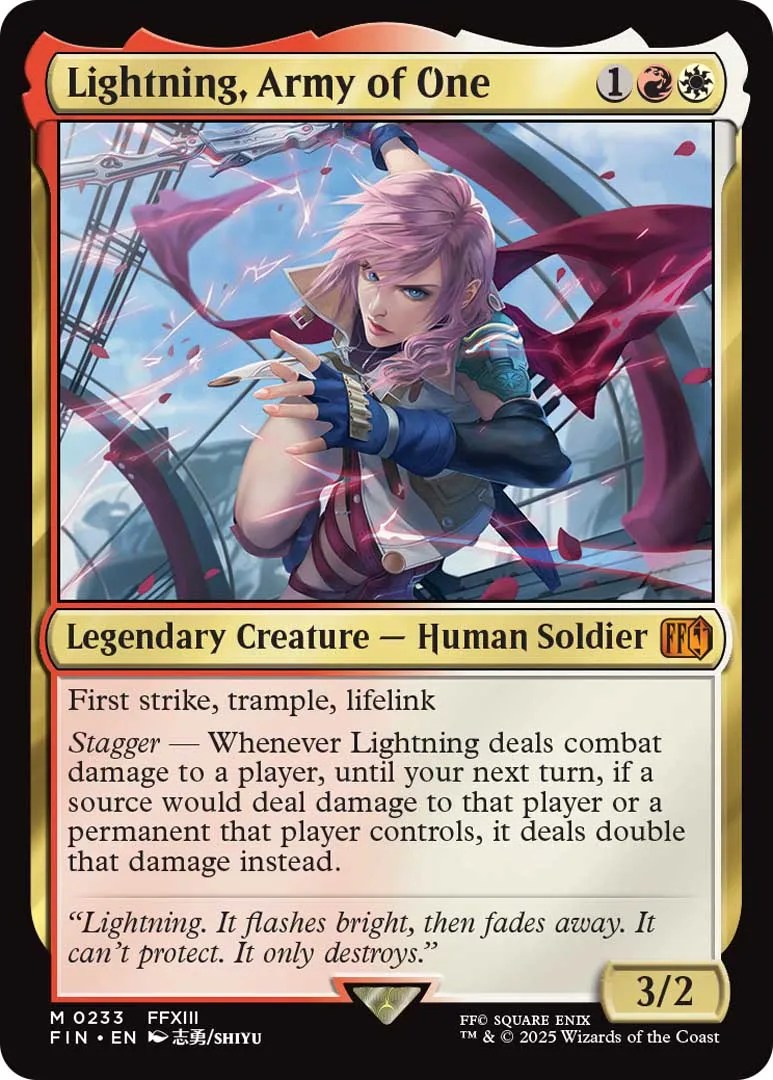Summary
First announced in October 2024 with some additional reveals throughout the new year, the reveal of theMagic: The GatheringxFinal Fantasycollaboration took the internet by storm. While not allMTGfans like the idea of Universes Beyond sets, with them now being legal in most formats - meaning Limited and Standard too - they have proven time and again to be some of the best-selling products the IP has ever put out.MTG’s upcomingFinal Fantasycollabis set to become the single most profitable release ever for the TCG, and it’s already sold out online ahead of its release on multiple platforms.
There is a lot to unpack inMagic: The Gathering’s newFinal Fantasyset, from the inspiration behind each card in terms of stories and characters to the thought process that led to the various abilities and color combinations. Game Rant attended a digital briefing regarding what Wizards of the Coast has in store for the massiveFinal FantasyUB set, and it seems like the ultimate love letter to fans of bothMTGandFFalike.

How Wizards of the Coast Worked on Final Fantasy Cards For MTG
There are three tiers that WotC used to determine the importance of a givenFFmoment to translate it intoMTG. These are:
Final Fantasy’s Jobs Remain a Huge Staple Even in Magic: The Gathering
The “Job select” mechanic is to represent the series' RPG roots, starting with the firstFinal Fantasygame, and coming in the form of cards like White Mage’s Staff and Black Mage’s Rod. FromFF1is also the newGarland, Knight of Cornelia card, which sets the stage for many other villains (and some heroes) of the series translated intoMTG, as it is a double-faced card with the ability to transform into a different creature - Chaos, the Endless. This is a great way to represent iconicFinal Fantasycharacters, as many of them have additional forms in the video games.
How MTG Turns FF2’s Weapon Proficiency Into Gameplay Mechanics
ForFinal Fantasy 2, WotC decided to include cards that have abilities tied to equipment and “weapons.” This is because a major mechanic inFF2is to gain weapon levels or proficiency with a weapon, and sinceMagic: The Gathering’s mechanicsinclude the existing ability for creatures to equip artifacts, it’s a good match. An example can be found in Firion, Wild Rose Warrior, which gives haste to all equipped creatures a player controls, and then also allows its owner to create tokens that are copies of equipment cards.
Magic: The Gathering’s Use of FF3’s Crystals Explained
InFinal Fantasygames, crystals are often an important part of the story or lore. InFF3, the protagonists acquire their powers from elemental crystals based on wind, fire, water, and earth. SinceMagic: The Gatheringhas five colors of mana, WotC created a fifth crystal, in the game called The Darkness Crystal, which instead represents a version of the elemental crystals in the world of darkness.
Final Fantasy 4 Turns Character Development Into Card Mechanics in MTG
As forFinal Fantasy 4, WotC found a way to represent how the game treats character development. For example,FF4’s Ceciland Kain both have their stories told in their respective cards - Cecil starts as a dark knight that loses the owner life and transforms into a paladin with lifelink to restore what was lost, whereas the complex character that is Kain betrays the party and becomes an enemy, which is represented by being a card that changes owners.
FF5 Has No Small Part in The MTG Collab
Final Fantasy 5fans will recognize theiconic villain Gilgameshin itsMTGversion of Gilgamesh, Master-at-Arms, which has synergy with equipment cards as well as samurai creatures, making it perfect forMTG’s Commander decks. This card cheats equipment cards onto the battlefield, which could be a reference to the character’s habit of masking his failures.
How Final Fantasy 6 and The Series' Summons Play Into MTG
Another big part of theFinal Fantasyseries is the presence of Summons, which are both sagas andcreatures inMagic: The Gathering. An example is Esper Valigarmanda, which is a Red card with 3 power and toughness, and a set of effects that will progress over time, like usual saga cards. There is also another card dedicated toFinal Fantasy 6’s Terra, and it is Terra, Magical Adept, which has the ability to transform into the other face of the card as Esper Terra, another Summon. Much like Terra has a double-face card, Kefka gets the same treatment, with Kefka, Court Mage transforming into Kefka, Ruler of Ruin, just like in the games.
Final Fantasy 7 Proves to Be a Massive Game For MTG Too
Final Fantasy’s Chocobosare iconic creatures, and WotC will have a set of premier ones tied toFF7. The main Chocobo in the set is the Traveling Chocobo, which has different color variations that players can find in collector booster packs, including the serialized “golden Chocobo,” of which there will be 77 in the entire world.
FF7’s Chocobo racing minigameis translated into MTG with different colors of the Traveling Chocobo card.

Of course,Final Fantasy 7’s Cloudis part of the collaboration, and the main card players will find in their booster packs is Cloud, Midgar Mercenary. This is a Mythic card, and it allows the owner to search their library for an equipment card and put it into their hand. Additionally, if Cloud is equipped, the creature’s abilities or equipment cards trigger an additional time, which WotC teases will have an effect on the iconic Buster Sword.
Anotherbig part ofFF7is Sephiroth. InMTG, there will be Sephiroth, Fabled Soldier, capable of transforming into Sephiroth, One-Winged Angel. This card is a draw engine with great capabilities for sacrificing creatures (and thus triggering combos), as well as making the opponent lose life. It’s likely going to be one of the most sought-after cards in the set, and understandably so, as it’s very strong.

Final Fantasy 8’s Story is Front and Center in MTG
Squall fromFinal Fantasy 8is also in theMagic: The Gatheringcrossover, as one would expect, and he has the Rough Divide ability to call back the level 56 move of the same name. Rinoa is also in the set, as Rinoa Heartilly, a Legendary creature inMTGthat creates the dedicated Angelo token, a 1/1 dog.
How FF9 Shakes Things Up For The Magic: The Gathering Collab
Final Fantasy’s iconic “leveled spells"have their own mechanic with Tiered, which essentially acts as a modalMTGcard. This can be seen in Fire Magic, a card with an illustration of the notorious Black Mage Vivi fromFinal Fantasy 9. Alongside Vivi, who gets a Red/Blue card, is the infamousFF9villain, Kuja. Kuja, Genome Sorcerer is all about creating Wizard tokens and comboing with itself inMagic: The Gathering, eventually transforming into Trance Kuja, Fate Defied.
Another interesting choice WotC made is to introduce someFinal Fantasycharactersas in-universeMagic: The Gatheringcards. This can be seen withFF2’s Firion, and in the case ofFF9, Zidane Tribal can be found in booster packs as Ragavan, Nimble Pilferer, a popular card inMagic: The Gathering’s Modern and other formats, too.

Final Fantasy 11’s MMO Approach Works Perfectly With MTG’s Absolute Virtue Card
WithFinal Fantasy 11being an online game, WotC decided to shake things up a bit in terms of representation, which can be seen with Absolute Virtue. This card may not resonate with allFinal Fantasyfans, but it is born out of a specific moment inFF11’s history. Absolute Virtue was conceived as the ultimate endgame boss, meaning that a lot of fans needed to play together to defeat it, but it was very difficult to beat and required many attempts and different strategies, changing over time as the game was patched. InMagic: The Gathering, this is translated in gameplay terms with Absolute Virtue being immune to counters and having protection from each opponent, meaning it can’t be damaged, enchanted, or targeted by one’s opponents.
MTG’s Vehicle Cards Play Into FF12’s Balthier and Fran’s Identity
Final Fantasy 12’s settingand mechanics are quite different from those of its predecessor, and it’s a return to form for the series. InMTG, there will be a card inspired by the duo of Balthier and Fran, representing their relationship and dynamic into its illustration, and then part of their story in the card’s ability to useMagic: The Gathering’s vehicles to their fullest. This calls back to the many airships inFF12, taking the Balthier and Fran card to the next level.
MTG’s FF13 Cards Steal a Page Out of Yu-Gi-Oh!’s Playbook With Card Fusion
FF13’s stagger mechanicis translated intoMTGwith the same name, only it allows players to deal double damage with a source they control if one with stagger dealt damage to a player before that. This appears on Lightning, Army of One, and makes for a great addition to the game in terms of strategies. It could likely find a lot of play inMagic: The Gathering’s Standard format, whereas the cards for Fang and Vanille fusing into Ragnarok, Divine Deliverance could find play in Limited due to their ease of access.
How Magic: The Gathering Incorporates FF14’s Online World
The Summoner’s Grimoire equipment card reflects the classes inFinal Fantasy 14by having the Job select mechanic, much like cards inspired byFF1. This specific card adds the “shaman” creature type to the list of types of the equipped creature, and allows players to cheat creatures into play from the hand.
To represent the conflict inFF14is Zodiark, Umbral God, which is indestructible and makes each player sacrifice half their creatures upon entering, also gaining a +1/+1 counter for each of them. This is based onFinal Fantasy 14’s Dark Inside trial, which was added in patch 6.0.

MTG’s Clever Use of Final Fantasy 15’s Armiger Explained
The card that’s front and center forFF15is Noctis, Prince of Lucis. The connection between the card and the games lies inFinal Fantasy 15’s Armiger, which allows Noctis to wield the 13 royal arms of the kingdom of Lucis, so the character’s counterpart inMagic: The Gatheringis all about casting artifact spells from the graveyard by paying life, and with Noctis, Prince of Lucis' lifelink, players can then recoup the cost by attacking.
All 13 royal arms from FF15 are included in the card’s illustration.

Final Fantasy 16’s Eikons and Magic: The Gathering’s Double-Face Cards Are a Match Made in Heaven
Since WotC started working on theMTGxFinal Fantasycollab for several years, the developers had to reserve some slots forFinal Fantasy 16before it came out, and then play through it all on release to figure out how to incorporate its story and characters into the game. The card dedicated to Clive is called Clive, Ifrit’s Dominant, and allows players to turn it face down and transform it into Ifrit, Warden of Inferno - another Summon that has the saga and creature types. This is perfect forFinal Fantasy 16, as theDominants turn into the Eikons, making the double-face card type a great fit.
How Magic: The Gathering Pays Homage to Final Fantasy’s Cid
Last but not least, the set includes 15different versions of the new Cid, Timeless Artificer card. As manyFinal Fantasyplayers may know, each game in the series features a character named Cid who is more or less pivotal to the story, and this is the case for theMTGcollab as well. Though all copies of Cid, Timeless Artificer are functionally identical, there are 15 different illustrations for it depicting each version of the character, barring that ofFF16.